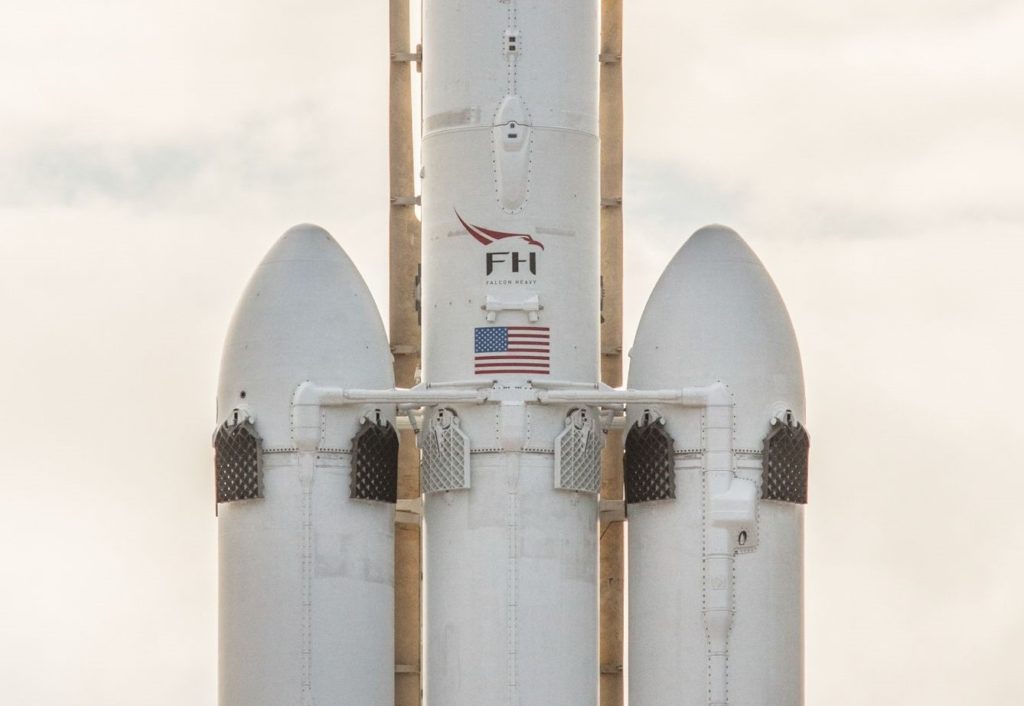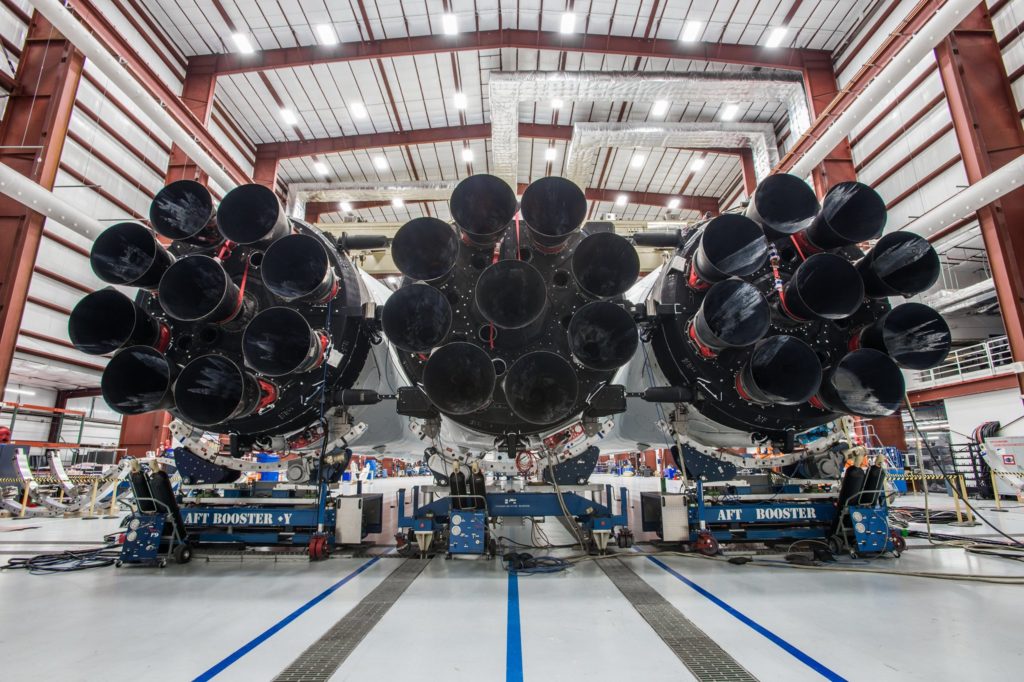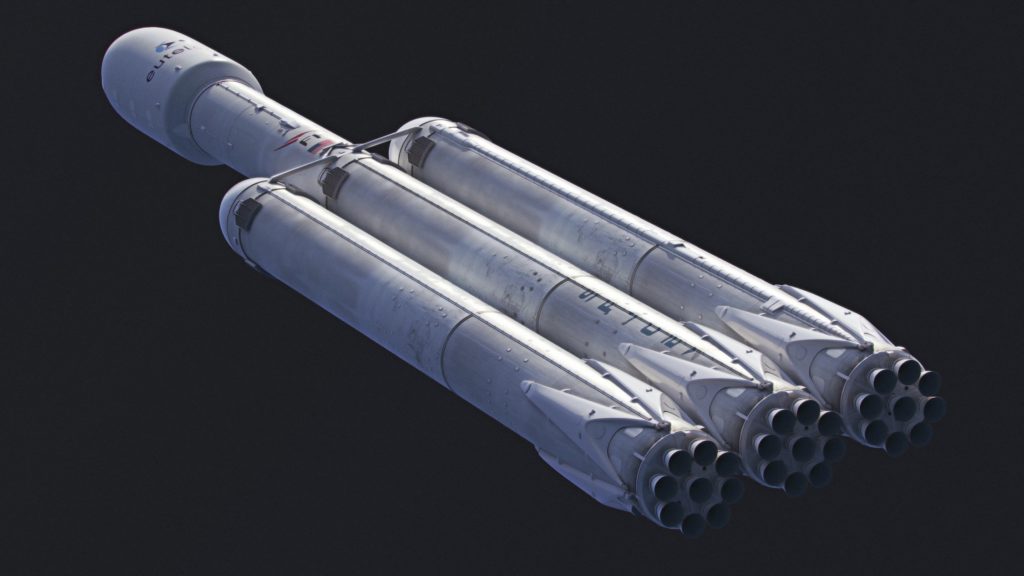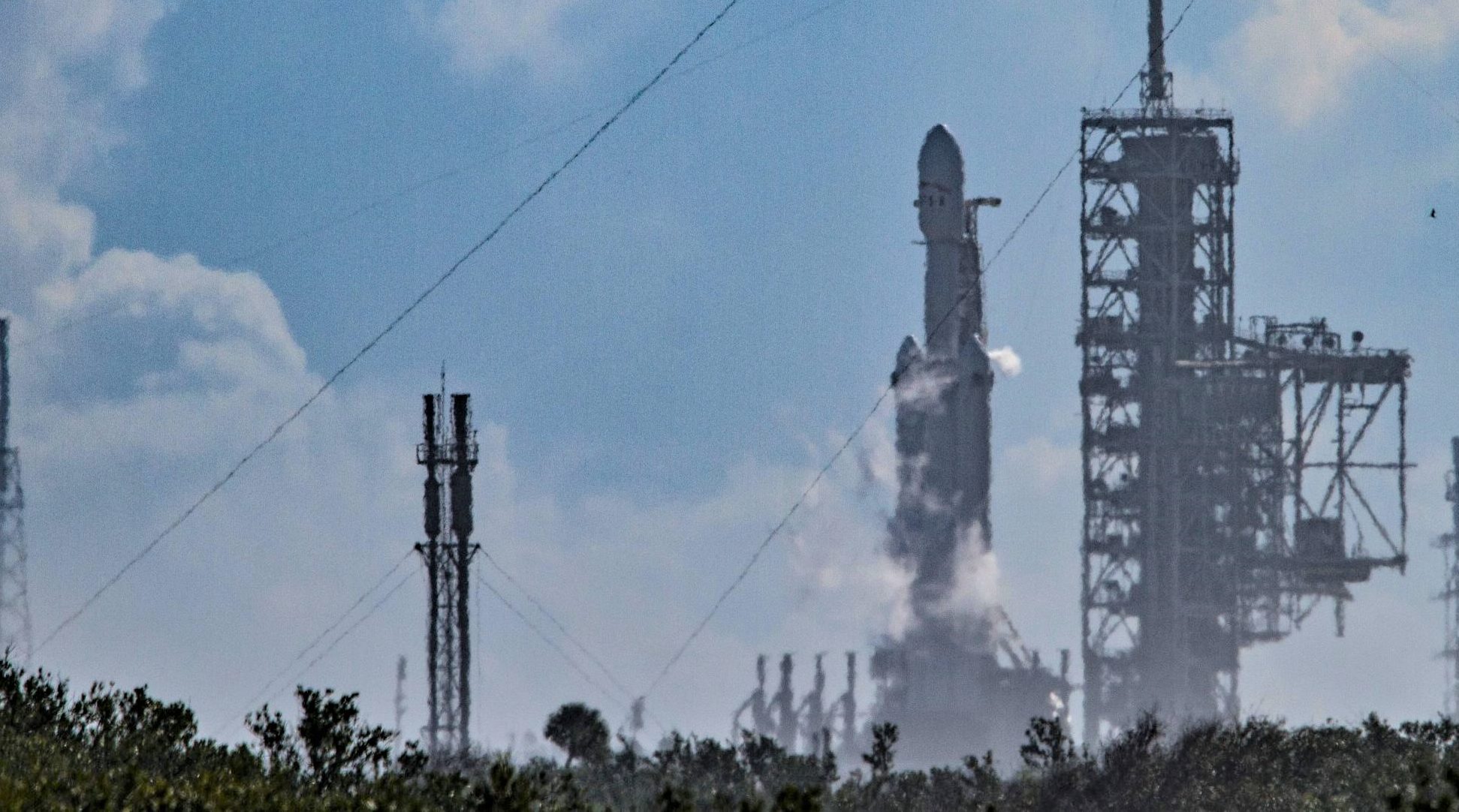
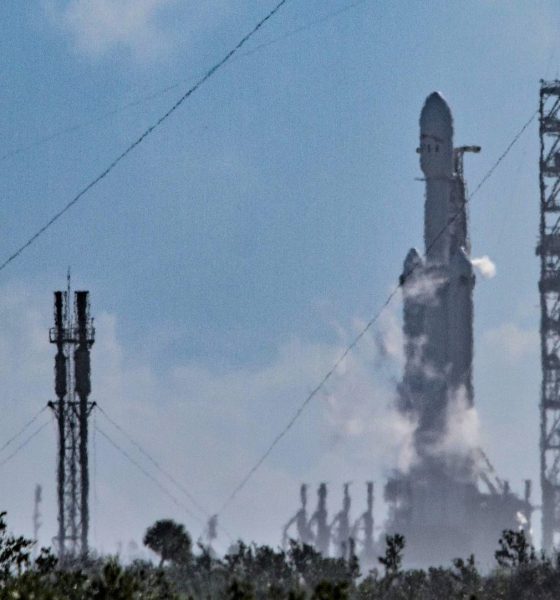
News
What’s causing SpaceX’s Falcon Heavy delays?
Although uncertainty in the schedule remains, SpaceX’s Falcon Heavy rocket appears to be nearly ready for its first engine ignition test (called a ‘static fire’) sometime within the next week or so.
An attempt at 1 PM EST today, January 16, was canceled for unspecified reasons, although Kennedy Space Center reportedly maintained the usual roadblock to prevent vehicles from driving past, implying that SpaceX still intends to conduct propellant loading tests with Falcon Heavy. It was noted earlier this morning by spaceflight journalist Chris Bergin that things were “a bit too quiet” if a test was indeed planned for today, and his intuition appears to have been correct. It still remains the case that Falcon Heavy is an experimental and untested rocket to an extent, and these delays are to be expected as SpaceX works out the inevitable kinks and bugs that arise during the extensive testing big launch vehicle has been and is still being put through.
KSC is in roadblock stance, so they will still do some testing it would seem, but we will have to wait for the Static Fire itself. https://t.co/DxzsRn85NR
— NSF – NASASpaceflight.com (@NASASpaceflight) January 16, 2018
Due to range requirements in support of an upcoming launch of the United Launch Alliance’s (ULA) Atlas 5 rocket, currently NET Thursday, SpaceX has postponed the static fire of Falcon Heavy without a replacement date. It is unlikely that another attempt will occur before the upcoming weekend, but SpaceX should have at least a solid week of uninterrupted range support once ULA’s launch occurs, hopefully without delay. Godspeed to ULA, in the meantime.
The crazy complexity of rocketry
Most recently, and perhaps somewhat related to Falcon Heavy’s static fire delays, SpaceX completed as many as two complete wet dress rehearsals (WDRs), which saw Falcon Heavy topped off with full tanks of its cryogenic (super cool) liquid oxygen (LOX) and rocket-grade jet fuel (RP-1). In essence, the rocket became equivalent to several hundred tons of carefully stabilized explosive. Nominally, these rehearsals appear entirely uneventful to an outside observer, with little more than ice formation and the occasional bursts of propellant tank vents to suggest that something important is occurring. However, anomalies like the failure of Falcon 9 during the Amos-6 static fire provide a staggering demonstration of just how explosive and sensitive a rocket’s fuel is, and Falcon Heavy has approximately three times the fuel capacity of Falcon 9. Empty, Falcon 9’s mass has been estimated to be around 30 metric tons, a minuscule amount of structure in the face of the more than 500 metric tons of propellant the vehicle carries at liftoff.
These propellant loading tests can also be challenging for reasons aside from their highly explosive nature. Due to basic realities of the physical nature of metal, the predominate ingredient for Falcon 9’s load-bearing structures, metallic structures shrink under extreme cold (and expand under heating). In the case of Falcon 9’s massive 45 meters (150 foot) tall first stage, the scale of this contraction can be on the order of several inches or more, particularly given SpaceX’s predilection towards cooling their propellant as much as possible to increase its energy density. For Falcon 9, these issues (thermodynamic loads) are less severe. However, add in three relatively different first stage boosters linked together with several extremely strong supports at both their tops and bottoms and that dynamic loading can become a fickle beast. The expansion or compression of materials due to temperature changes can create absolutely astounding amounts of pressure – if you’ve ever forgotten a glass bottled drink in the freezer and discovered it violently exploded at some future point, you’ll have experienced this yourself.
With several inches of freedom and the possibility that each Falcon Heavy booster might contract or expand slightly differently, these forces could understandably wreak havoc with the high precision necessary for the huge rocket to properly connect with the launch pad’s ground systems that transmit propellant, fluids, and telemetry back and forth. Information from two reliable Kennedy Space Center sources experienced with the reality of operating rockets, as well as NASASpaceflight.com, suggested that issues with dynamic loads (such as those created by thermal contraction/expansion) are a likely explanation for the delays, further evidenced by their observations that much of the pad crew’s attention appeared to be focused at the base of Transporter/Erector/Launcher (TEL). The TEL base hosts the clamps that hold the rocket down during static fires and launches, as well as the Tail Service Masts (TSMs) that connect with the Falcon 9/Heavy to transport propellant and data to the first stage(s). These connection points are both relatively tiny, mechanically sensitive, and absolutely critical for the successful operation of the rocket, and thus are a logical point of failure in the event of off-nominal or unpredicted levels of dynamic stresses.
- The white bars in this photo are half of Falcon Heavy’s seperation mechanism. A number of actuators take the place of the more common solid rocket motors used with vehicles like the Delta IV Heavy. (SpaceX)
- Falcon Heavy’s three boosters and 27 Merlin 1D engines on full display. (SpaceX)
- Falcon Heavy. Modeled and rendered by NASASpaceflight forum user WBY1984. (WBY1984)
Test, launch, land, repeat.
All things considered, these difficulties demonstrate that even after months (even years) of relentless modeling, testing, remodeling, and retesting, rockets (and especially huge rockets like Falcon Heavy) are immensely complex, and even tiny mistakes can lead the vehicle to stray from its expected behavior. Quite simply, the reality of engineering only truly comes into play once hardware is fully in the loop, and it’s in this state that SpaceX has demonstrated again and again a distinct and elegant ability to learn from their hardware, rather than attempt to salve uncertainty with a neurotic and counterproductive level of statistical analysis, modelling, and documentation. The agile launch company still dabbles in those aspects when beneficial or necessary, but testing comes first in its importance.
The conclusion here, then, is that Falcon Heavy’s delays betray this aspect of SpaceX – a launch company that loves its fans, but also understands the need for cautious testing when it comes to new and untried rocket hardware. Whether Falcon Heavy succeeds or fails, SpaceX will learn from the proceedings, and they will be better off for it (although maybe less so financially…).
Follow along live as launch photographer Tom Cross and I cover these exciting proceedings as close to live as possible.
Teslarati – Instagram – Twitter
Tom Cross – Instagram
Eric Ralph – Twitter

News
Tesla refines Full Self-Driving, latest update impresses where it last came up short
We were able to go out and test it pretty extensively on Saturday, and the changes Tesla made from the previous version were incredibly impressive, especially considering it seemed to excel where it last came up short.

Tesla released Full Self-Driving v14.2.1.25 on Friday night to Early Access Program (EAP) members. It came as a surprise, as it was paired with the release of the Holiday Update.
We were able to go out and test it pretty extensively on Saturday, and the changes Tesla made from the previous version were incredibly impressive, especially considering it seemed to excel where it last came up short.
Tesla supplements Holiday Update by sneaking in new Full Self-Driving version
With Tesla Full Self-Driving v14.2.1, there were some serious regressions. Speed Profiles were overtinkered with, causing some modes to behave in a strange manner. Hurry Mode was the most evident, as it refused to go more than 10 MPH over the speed limit on freeways.
It would routinely hold up traffic at this speed, and flipping it into Mad Max mode was sort of over the top. Hurry is what I use most frequently, and it had become somewhat unusable with v14.2.1.
It seemed as if Speed Profiles should be more associated with both passing and lane-changing frequency. Capping speeds does not help as it can impede the flow of traffic. When FSD travels at the speed of other traffic, it is much more effective and less disruptive.
With v14.2.1.25, there were three noticeable changes that improved its performance significantly: Speed Profile refinements, lane change confidence, and Speed Limit recognition.
🚨 Many of you asked us to test highway driving with Tesla Full Self-Driving v14.2.1.25. Here’s what we noticed:
✅ Speed Profiles are significantly improved. Hurry Mode is no longer capped at 10 MPH over the speed limit, and now travels with the flow of traffic. This is much… pic.twitter.com/48ZCGbW0JO
— TESLARATI (@Teslarati) December 13, 2025
Speed Profile Refinement
Speed Profiles have been significantly improved. Hurry Mode is no longer capped at 10 MPH over the speed limit and now travels with the flow of traffic. This is much more comfortable during highway operation, and I was not required to intervene at any point.
With v14.2.1, I was sometimes assisting it with lane changes, and felt it was in the wrong place at the wrong time more frequently than ever before.
However, this was one of the best-performing FSD versions in recent memory, and I really did not have any complaints on the highway. Speed, maneuvering, lane switching, routing, and aggressiveness were all perfect.
Lane Changes
v14.2.1 had a tendency to be a little more timid when changing lanes, which was sort of frustrating at times. When the car decides to change lanes and turn on its signal, it needs to pull the trigger and change lanes.
It also changed lanes at extremely unnecessary times, which was a real frustration.
There were no issues today on v14.2.1.25; lane changes were super confident, executed at the correct time, and in the correct fashion. It made good decisions on when to get into the right lane when proceeding toward its exit.
It was one of the first times in a while that I did not feel as if I needed to nudge it to change lanes. I was very impressed.
Speed Limit Recognition
So, this is a complex issue. With v14.2.1, there were many times when it would see a Speed Limit sign that was not meant for the car (one catered for tractor trailers, for example) or even a route sign, and it would incorrectly adjust the speed. It did this on the highway several times, mistaking a Route 30 sign for a 30 MPH sign, then beginning to decelerate from 55 MPH to 30 MPH on the highway.
This required an intervention. I also had an issue leaving a drive-thru Christmas lights display, where the owners of the private property had a 15 MPH sign posted nearly every 200 yards for about a mile and a half.
The car identified it as a 55 MPH sign and sped up significantly. This caused an intervention, and I had to drive manually.
It seems like FSD v14.2.1.25 is now less reliant on the signage (maybe because it was incorrectly labeling it) and more reliant on map data or the behavior of nearby traffic.
A good example was on the highway today: despite the car reading that Route 30 sign and the Speed Limit sign on the center screen reading 30 MPH, the car did not decelerate. It continued at the same speed, but I’m not sure if that’s because of traffic or map data:
🚨 We listened to and read a lot of you who had a complaint of Tesla Full Self-Driving v14.2.1 incorrectly reading Speed Limit signs
This appears to be resolved in v14.2.1.25.
Here’s a breakdown: pic.twitter.com/TEP03xrMbt
— TESLARATI (@Teslarati) December 13, 2025
A Lone Complaint
Tesla has said future updates will include parking improvements, and I’m really anxious for them, because parking is not great. I’ve had some real issues with it over the past couple of months.
Today was no different:
🚨 My lone complaint with my drive on Tesla FSD v14.2.1.25 was this strange parking instance.
FSD swung out wide to the left to pull into this spot and this is where it seemed to be stumped. I gave it about 10 seconds after the car just stopped moving for it to make some… https://t.co/ZEkhTHOihG pic.twitter.com/TRemXu5DLf
— TESLARATI (@Teslarati) December 13, 2025
Full Self-Driving v14.2.1.25 is really a massive improvement over past versions, and it seems apparent that Tesla took its time with fixing the bugs, especially with highway operation on v14.2.1.
News
Tesla hints at Starlink integration with recent patent
“By employing polymer blends, some examples enable RF transmission from all the modules to satellites and other communication devices both inside and outside the vehicle.”

Tesla hinted at a potential Starlink internet terminal integration within its vehicles in a recent patent, which describes a vehicle roof assembly with integrated radio frequency (RF) transparency.
The patent, which is Pub. No U.S. 2025/0368267 describes a new vehicle roof that is made of RF-transparent polymer materials, allowing and “facilitating clear communication with external devices and satellites.”
Tesla believes that a new vehicle roof design, comprised of different materials than the standard metallic or glass elements used in cars today, would allow the company to integrate modern vehicular technologies, “particularly those requiring radio frequency transmission and reception.
Tesla has recently filed a US patent application on integrating RF transparent materials into the roof structure.
“facilitating clear communication with external devices and satellites”
Tesla fleet is getting @Starlink connectivity integration soon. LFG @Tesla @elonmusk… pic.twitter.com/bLa8YtPLd1
— Chansoo Byeon (@Chansoo) December 9, 2025
Instead of glass or metallic materials, Tesla says vehicles may benefit from high-strength polymer blends, such as Polycarbonate, Acrylonitrile Butadiene Styrene, or Acrylonitrile Styrene Acrylate.
These materials still provide ideal strength metrics for crashworthiness, stiffness for noise, vibration, and harshness control, and are compliant with head impact regulations.
They would also enable better performance with modern technologies, like internet terminals, which need an uninterrupted signal to satellites for maximum reception. Tesla writes in the patent:
“By employing polymer blends, some examples enable RF transmission from all the modules to satellites and other communication devices both inside and outside the vehicle.”

One of the challenges Tesla seems to be aware of with this type of roof design is the fact that it will still have to enable safety and keep that at the forefront of the design. As you can see in the illustration above, Tesla plans to use four layers to increase safety and rigidity, while also combating noise and vibration.
It notes in the patent that disclosed examples still meet the safety requirements outlined in the Federal Motor Vehicle Safety Standards (FMVSS).
Starlink integrated directly into Tesla vehicles would be a considerable advantage for owners. It would come with a handful of distinct advantages.
Initially, the inclusion of Starlink would completely eliminate cellular dead zones, something that is an issue, especially in rural areas. Starlink would provide connectivity in these remote regions and would ensure uninterrupted service during road trips and off-grid adventures.
It could also be a critical addition for Robotaxi, as it is crucial to have solid and reliable connectivity for remote monitoring and fleet management.
Starlink’s growing constellation, thanks to SpaceX’s routine and frequent launch schedule, will provide secure, stable, and reliable internet connectivity for Tesla vehicles.
Although many owners have already mounted Starlink Mini dishes under their glass roofs for a similar experience, it may be integrated directly into Teslas in the coming years, either as an upgrade or a standard feature.
News
Tesla supplements Holiday Update by sneaking in new Full Self-Driving version
It seems Tesla was waiting for the Hardware 4 rollout, as it wanted to also deploy a new Full Self-Driving version to those owners, as it appeared in the release notes for the Holiday Update last night.

Tesla has surprised some owners by sneaking in a new Full Self-Driving version with the wide release of the Holiday Update, which started rolling out to Hardware 4 owners on Friday night.
Tesla has issued a controlled and very slow release pattern with the Holiday Update, which rolls out with Software Version 2025.44.25.5.
For the past two weeks, as it has rolled out to Hardware 3 and older Tesla owners, the company has kept its deployment of the new Software Version relatively controlled.
It seems Tesla was waiting for the Hardware 4 rollout, as it wanted to also deploy a new Full Self-Driving version to those owners, as it appeared in the release notes for the Holiday Update last night.
Tesla Full Self-Driving v14.2.1.25 made its first appearance last night to Hardware 4 owners who are members of the Early Access Program (EAP). It appears to be a slight refinement from FSD v14.2.1, which has been out for a couple of weeks.
Tesla v2025.44.25.5 Holiday update incoming
Also Full Self-Driving v14.2.1.25!!! pic.twitter.com/74D7S0UGXz
— TESLARATI (@Teslarati) December 13, 2025
Many owners welcome the new FSD version, us included, because we’ve been less than impressed with v14.2.1. We have experienced some minor regressions with v14.2.1, especially with Speed Limit recognition, Speed Profile tinkering, and parking performance.
As it stands, Full Self-Driving is still particularly impressive, but Tesla is evidently having an issue with some of the adjustments, as it is still refining some of the performance aspects of the suite. This is expected and normal with some updates, as not all of them are an improvement in all areas; we routinely see some things backtrack every once in a while.
This new FSD version is likely to take care of those things, but it also includes all of the awesome Holiday Update features, which include:
- Grok with Navigation Commands (Beta) – Grok will now add and edit destinations.
- Tesla Photobooth – Take pictures inside your car using the cabin-facing camera
- Dog Mode Live Activity – Check on your four-legged friend on your phone through periodic snapshots taken of the cabin
- Dashcam Viewer Update – Includes new metrics, like steering wheel angle, speed, and more
- Santa Mode – New graphics, trees, and a lock chime
- Light Show Update – Addition of Jingle Rush light show
- Custom Wraps and License Plates – Colorizer now allows you to customize your vehicle even further, with custom patterns, license plates, and tint
- Navigation Improvements – Easier layout and setup
- Supercharger Site Map – Starting at 18 pilot locations, a 3D view of the Supercharger you’re visiting will be available
- Automatic Carpool Lane Routing – Navigation will utilize carpool lanes if enabled
- Phone Left Behind Chime – Your car will now tell you if you left a phone inside
- Charge Limit Per Location – Set a charge limit for each location
- ISS Docking Simulator – New game
- Additional Improvements – Turn off wireless charging pad, Spotify improvements, Rainbow Rave Cave, Lock Sound TRON addition
Tesla also added two other things that were undocumented, like Charging Passport and information on USB drive storage to help with Dashcam.
